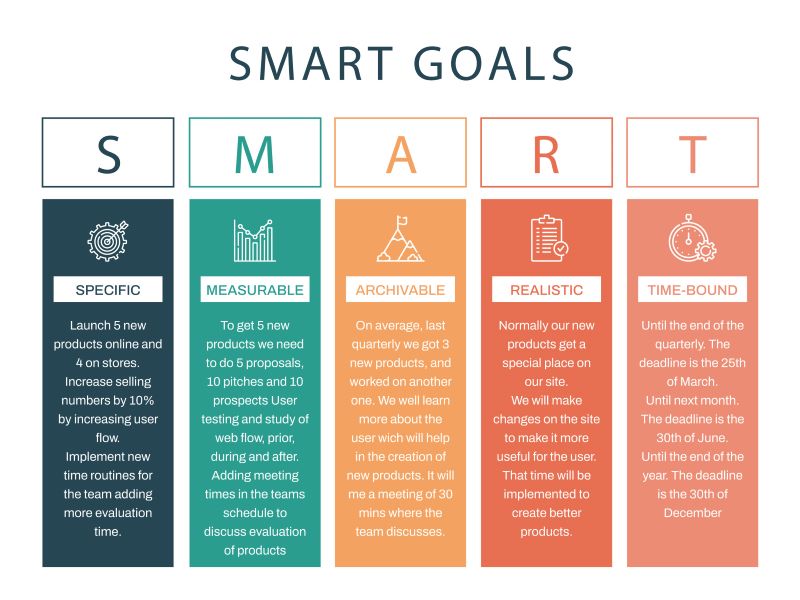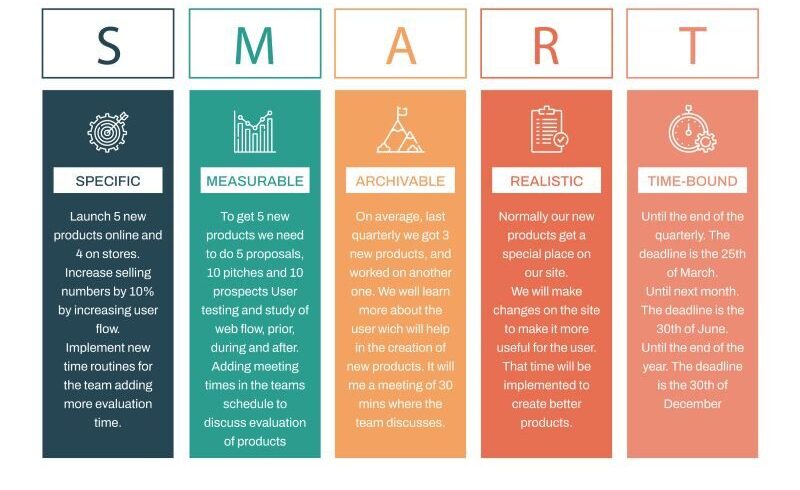SMART goals ensure success by focusing on specific, measurable, attainable, relevant, and time-based factors. It increases motivation, widens focus, signifies importance, and directs action towards a targeted aim. These goals were defined in 1981 by George Doran, Arthur Miller, and James Cunningham to write management objectives. This tool is highly recommended in the lean methodology to accomplish any goal.
What are smart goals?
Today, many industries use this strategy to reach the intended objectives effectively. Let’s elaborate all the five key aspects:

Specific
It is crucial to be specific about the desired purpose while setting goals. Be clear about the final result by asking yourself WH questions.
- What: Be precise about what will be the final outcome of your goal
- Where: This question is less significant while performing this for your personal achievement. Get clear regarding the particular event or location, if necessary.
- Who: This question signifies people involved in a project or a group activity.
- Which: Determine the blocks you may encounter or particular requirements while fulfilling your goal. If you notice any potential barriers, focus on clearing the path or getting thighs ready to proceed.
- Why: Why will let you know the reason behind setting the goal or the desired objective.
- When: This question will define the timeframe of the goal so the scheduling of all the activities will be smooth.
Examples of specific smart goals
- Increasing the website traffic by 5% in the next 10 days.
- Signing two new deals in the next 20 days.
Measurable
After setting specific goals, decide how to measure the progress or effectiveness of the task. Set particular milestones to track the progress, if it is a matter of a few months or years. These milestones could be phases or steps that make a complete goal. You can implement both qualitative (surveys, testimonials, etc.) as well as quantitative (productivity, expenditure records, etc.) methods to measure goals. Typically, data collection includes audits, tests, reports, samples, work products, etc. Sometimes it can be hard to decide the measurable criteria. In that case, the whole team needs to brainstorm ideas that are feasible and practical. While planning the project, it is vital to determine the measurement option to obtain the end result.

If you are interested in learning about audits and reports, refer to our article on 15 Most Valuable Terms to Understand ISO 9001:2015.
Examples of measurable smart goals
- Walking one km distance for four days/week.
- Increasing Instagram followers by 15% within two months.
Attainable
Determine what it takes to attain that goal. It can involve the required skillset, strategies, and the other things to make it attainable.
Examples of attainable smart goals
- Writing 2000 words for each blog twice a week.
- Increasing YouTube subscribers by 5% within a month.
Relevant
Ensure that your efforts are in line with the strategic direction and priorities set by your organization. Relevance entails concentrating on activities that align with the objectives of your business. While your team may have the capability to begin a project, if the division is not currently prioritizing such endeavors, then pursuing that goal would be irrelevant.

Examples of relevant smart goals
- Increasing mutual fund investment by 4% after each raise.
- Doing yoga for 40 minutes every weekend.
Time-bound
Setting clear deadlines for deliverables is crucial in any project. It is important to gather specific details about the timeline and the tasks to be accomplished within that timeframe. This will ensure a smooth workflow and allow for timely evaluation of progress.
Begin by thinking about the broad scope of your responsibilities. Structure the goal statement and decide the core outcome. Ensure they are applicable to your work. You can also determine the scope of smart goals by performing a SWOT analysis.

Examples of time-bound smart goals
- Growing the number of sales orders by 10% within two months.
- Creating content for two blogs by the weekend.
How to track goals
Write
As we all know, writing is an effective strategy to manifest your goals. So write them down with all the details. Update as necessary and also modify them according to the requirement.
Share
Remember to share goals with the relevant people and make yourself accountable. Shared goals are powerful motivators that come with a strong commitment to working diligently towards reaching them. It’s essential to align yourself with someone who shares your goals and acts as a supportive force, encouraging you to strive during challenging times. Surrounding yourself with such individuals will help you maintain the determination to overcome blocks and reach your objectives.
Assess
Stay on track and monitor your progress by regularly checking in. Consider having daily or weekly check-ins to assess your advancement for monthly goals. These are crucial as they allow you to identify areas that need improvement or adjustments. By redirecting energy and making necessary changes, you can ensure that you stay motivated and keep moving forward. Don’t wait until it’s too late to make a change – take action now while you still have the opportunity to adapt and thrive.

Celebrate
Celebrate all the milestones on a regular basis. Don’t wait until you accomplish the entire goal. Recognize your work, celebrate it, and proceed. This will keep you motivated throughout the process.
Advantages of setting smart goals
Smart goals have many benefits ranging from personal to professional life success.
- People can recognize their positive and negative aspects while setting goals. It gives them the opportunity to grow.
- Smart goals can either be easy or difficult to achieve at the same time. It pushes us to think out of the box and take bold steps.
- These goals are typically broken into smaller steps i.e., milestones to enhance focus and improve productivity.
- Results can be achieved faster by spending less time doing irrelevant tasks.
- Setting smart goals enhances individual performance.
If you are interested to learn more about smart goals, please write to us in the comment section.



